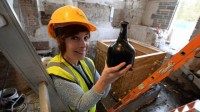 A hoard of 17th century luxury consumer goods was found hidden under the floor of a tower in Dublin’s Rathfarnham Castle. All the floors in the tower had been removed to construct an elevator shaft that would make the space wheelchair accessible (the work was monitored by an archaeologist since the castle is a National Monument). At the bottom of the tower underneath the 18th century stone floor, they discovered a large cache of what may have been garbage to the inhabitants of the castle, but would have been precious treasure to most people in their era and certainly in ours.
A hoard of 17th century luxury consumer goods was found hidden under the floor of a tower in Dublin’s Rathfarnham Castle. All the floors in the tower had been removed to construct an elevator shaft that would make the space wheelchair accessible (the work was monitored by an archaeologist since the castle is a National Monument). At the bottom of the tower underneath the 18th century stone floor, they discovered a large cache of what may have been garbage to the inhabitants of the castle, but would have been precious treasure to most people in their era and certainly in ours.
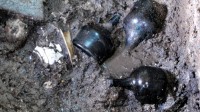 Because the cache was sealed by the floor, the hiding place had very little air circulating. It was also quite damp and muddy, which helped preserved organic matter as well as delicate artifacts like glass bottles and porcelain. It’s an impressively large collection. Archaeologists recovered them from the mud by the bucketful. The objects may have been hidden deliberately when the castle was under attack (which it was a lot in the mid-17th century), or they may have been set aside for washing and then forgotten about, or simply thrown away. Or maybe some things were stashed with the intention of retrieval while other items were dumped as trash.
Because the cache was sealed by the floor, the hiding place had very little air circulating. It was also quite damp and muddy, which helped preserved organic matter as well as delicate artifacts like glass bottles and porcelain. It’s an impressively large collection. Archaeologists recovered them from the mud by the bucketful. The objects may have been hidden deliberately when the castle was under attack (which it was a lot in the mid-17th century), or they may have been set aside for washing and then forgotten about, or simply thrown away. Or maybe some things were stashed with the intention of retrieval while other items were dumped as trash.
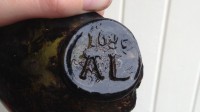 A number of late 17th century glass wine bottles, all intact, were found, some of which still had their seals, marked with a date stamp of 1688 and initials AL for Adam Loftus. Glass wine bottles only began to be used in 1650, so we’re talking very early survivals here of very fragile material. Another rare survival is of an intact crystal drinking glass, about the size and shape of a lipped shot glass. The crystal is much thinner than the wine bottles, so very few of them have made it out of their time without breaking. Then there’s the mysterious corked glass vial that still has liquid inside, possibly a perfume or essential oil. Its contents will be examined in a laboratory.
A number of late 17th century glass wine bottles, all intact, were found, some of which still had their seals, marked with a date stamp of 1688 and initials AL for Adam Loftus. Glass wine bottles only began to be used in 1650, so we’re talking very early survivals here of very fragile material. Another rare survival is of an intact crystal drinking glass, about the size and shape of a lipped shot glass. The crystal is much thinner than the wine bottles, so very few of them have made it out of their time without breaking. Then there’s the mysterious corked glass vial that still has liquid inside, possibly a perfume or essential oil. Its contents will be examined in a laboratory.
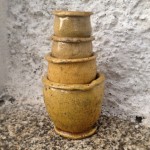 There is a complete set of pottery ointment or cosmetic jars, possibly made in Italy, one of which still has ointment in it. They’re graduated in size so they can stack neatly one inside the other. Porcelain wasn’t produced in England until 1750. Before then, it had to be imported from the far east. The porcelain discovered at Rathfarnham Castle is Chinese. The maker’s mark on the base of one plate identifies it as from the 1660s.
There is a complete set of pottery ointment or cosmetic jars, possibly made in Italy, one of which still has ointment in it. They’re graduated in size so they can stack neatly one inside the other. Porcelain wasn’t produced in England until 1750. Before then, it had to be imported from the far east. The porcelain discovered at Rathfarnham Castle is Chinese. The maker’s mark on the base of one plate identifies it as from the 1660s.
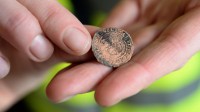 Other assorted objects include a group of clay pipes, chamber pots, coins going back as far as 1602, jewelry, buckles, shoes, a rare foldable travel toothbrush and weaponry. A Cromwellian armour breastplate with a musket ball hole in the lower abdomen is the stand-out piece amidst the gun flints and musket balls.
Other assorted objects include a group of clay pipes, chamber pots, coins going back as far as 1602, jewelry, buckles, shoes, a rare foldable travel toothbrush and weaponry. A Cromwellian armour breastplate with a musket ball hole in the lower abdomen is the stand-out piece amidst the gun flints and musket balls.
The organic remains testify to some very fine meals enjoyed at the castle. There are pits from olives, cherries, peaches and plums, melon and grape seeds, hazelnuts, oyster shells, fish bones, bird bones and perhaps most excitingly, tea leaves. Tea was also introduced in the mid-17th century, so again we’re looking at a very early luxury import.
 The artifacts tell a story about the early history of the castle and of the lives of the elite. Since the 17th century was a very tumultuous time of wars and rebellions, not a great many fragile artifacts have survived. Finding so many of them in one place is an archaeological gold strike.
The artifacts tell a story about the early history of the castle and of the lives of the elite. Since the 17th century was a very tumultuous time of wars and rebellions, not a great many fragile artifacts have survived. Finding so many of them in one place is an archaeological gold strike.
Built in 1583, the castle was the country retreat of Adam Loftus, Church of England Archbishop of Dublin, Lord Chancellor of Ireland, co-founder and first Provost of Trinity College Dublin. After his death in 1605, Rathfarnham Castle passed to his eldest son Sir Dudley Loftus and then to Dudley’s son Sir Adam Loftus in 1616. The artifacts date to Sir Adam’s tenure and that of his sons Sir Arthur and Dr. Dudley Loftus.
 As a Protestant English noble, Loftus was a target in the Irish Rebellion of 1641 and the castle was besieged by Irish Catholic forces. Adam was imprisoned, but the castle held out and was garrisoned by Royalist troops from 1641 through 1647 when Dublin surrendered to Parliamentary troops in the English Civil War. The Irish Catholic Confederation allied with the Royalists in 1648 and by 1649, Dublin was the only Parliamentary city in Ireland. Cromwell arrived in Ireland in August of 1649. He was said to have stayed at the castle and held council there before the Sack of Wexford in October of 1649. Adam Loftus sided with Cromwell and got his property back, only to be killed at the Siege of Limerick in 1651.
As a Protestant English noble, Loftus was a target in the Irish Rebellion of 1641 and the castle was besieged by Irish Catholic forces. Adam was imprisoned, but the castle held out and was garrisoned by Royalist troops from 1641 through 1647 when Dublin surrendered to Parliamentary troops in the English Civil War. The Irish Catholic Confederation allied with the Royalists in 1648 and by 1649, Dublin was the only Parliamentary city in Ireland. Cromwell arrived in Ireland in August of 1649. He was said to have stayed at the castle and held council there before the Sack of Wexford in October of 1649. Adam Loftus sided with Cromwell and got his property back, only to be killed at the Siege of Limerick in 1651.
 Dr. Dudley Loftus, a prodigy who graduated from Trinity College at age 18 and became a noted expert in languages, inherited Rathfarnham Castle in 1659. He held it in less turbulent times until his death in 1695. In addition to his reputation as a scholar and linguist, he also had a reputation as a voluptuary whose fondness for fashion, pageantry and women was known in some excruciating detail thanks to the pamphlets he himself wrote about his exploits. God knows what shenanigans those oysters were in aid of.
Dr. Dudley Loftus, a prodigy who graduated from Trinity College at age 18 and became a noted expert in languages, inherited Rathfarnham Castle in 1659. He held it in less turbulent times until his death in 1695. In addition to his reputation as a scholar and linguist, he also had a reputation as a voluptuary whose fondness for fashion, pageantry and women was known in some excruciating detail thanks to the pamphlets he himself wrote about his exploits. God knows what shenanigans those oysters were in aid of.
The artifacts have been removed to a laboratory for cleaning and conservation, after which they will be exhibited somewhere, ideally in the castle itself. Please watch the video at this link to see the tower floor and a lovely little tour of the artifacts recovered.